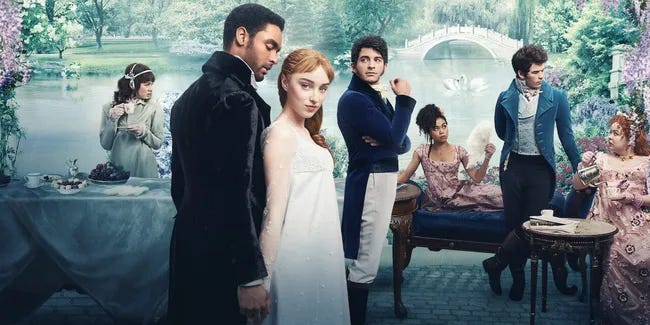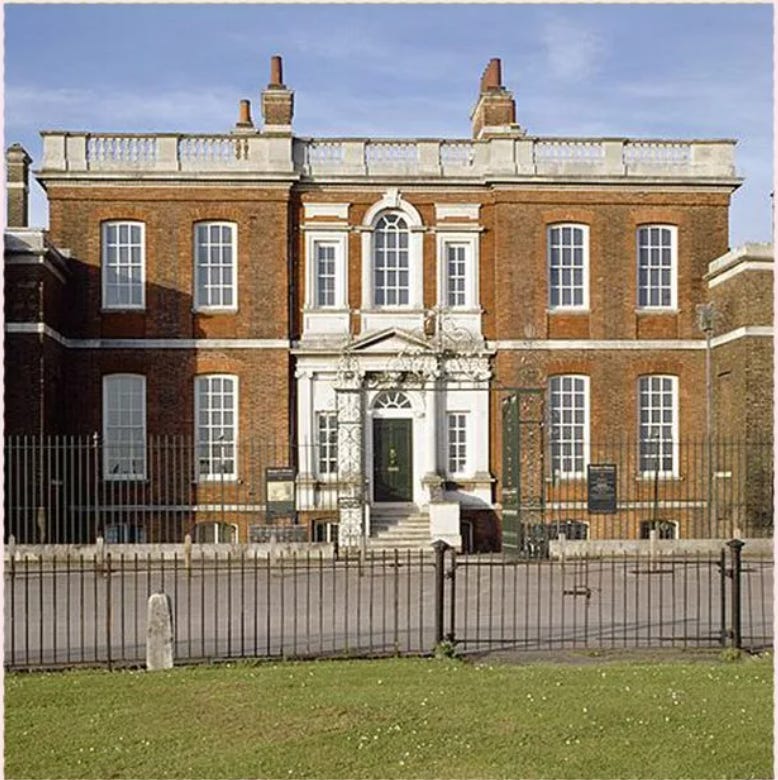Three Reasons Why Romantasy Writers Should Be Watching Bridgerton (Again)
Working Title: Imperfect characters, an immersive, fantasy-based setting, and a traditional Five-Act story structure combine to create a fantastic storyline.

Dearest Gentle Reader…
Shonda Rhimes’ adaptation of Julia Quinn’s romance series is a great study in storytelling for romantasy writers. Bridgerton is my TV love-match, coming in as my favorite TV show of all time. (Sorry 10th Doctor, but we knew this day would come). Seeing the fanciful elements of a Regency romance—complete with steamy scenes highlighting readers favorite tropes crafted in a meticulous, high production manner often reserved for more “serious” historical subjects—has left me hopeful the TV adaptations of ACOTAR and Fourth Wing will be as meticulously produced. All three seasons of Bridgerton are a masterclass in fantasy and romance storytelling by providing compelling, imperfect characters; an immersive, fantasy-based setting; and a traditional 5-Act story structure.
Ring for tea, don’t forget the biscuits, and get comfortable on your settee before reading further. Please note there are MAJOR SPOILERS for Bridgerton as well as Sarah J. Maas’s Throne of Glass series. You’ve been warned!
A Compelling Yet Imperfect Cast

Bridgerton’s massive appeal is due in no small part to the characters. Despite the fact there are EIGHT Bridgerton siblings and an entire aristocratic class referred to as the ton, the main characters each have a distinct personality, motivations, and conflicts that arise as they strive for their own version of happily-ever-after.
How is this achieved?
In both the source material and adaptation, each Bridgerton sibling is given the spotlight by staring in their own story. Daphne’s quest for a husband is the main plot of season one. However, her interactions with her mother, the eye-roll quips feminist sister Eloise, and the disdain big brother Vicount Antony has towards dismissing his mistress helps us understand exactly who Daphne is and why she seeks a love match.
Romance writers often utilize a common setting in which a large cast of characters inhabit to create a dynamic cast. This can be achieved by writing a large family that has both sibling interactions and trope-fueled romance, as Quinn has done. Other examples include developing a cast of a small town, village, or even a supernatural werewolf pack, where everyone knows everyone else, portraying the individuals as part of a larger unit that provides ample fodder for the writer.
However, this technique is not often seen in romantasy, where most series maintain the same main character and series goal over the course of multiple books. How can you create a large cast AND have the reader feel intimately familiar with the wants and needs of many characters?
Write a multiple POV book in which chapters and/or scenes are told from different characters within your world.
This allows for the large cast of linked characters, each with their own motivation and goal. The best example of this technique in romantasy is Sarah J. Maas’ Throne of Glass. She even uses the idea of having one character with his own book towards the end of the series. Tower of Dawn follows Chaol as he travels to the far-off southern continent while the rest of the gang deals with the fallout of Aelin’s captivity.
Ensure each POV character has their own wants, needs, strengths, and weaknesses.
No one wants to read a book starring a Mary Sue, nor are they interested in a narrative featuring a cast of cardboard characters. Bridgerton does this beautifully, setting up the characters from the beginning in a manner that allows them to grow and evolve over the course of the story.
Season One features Daphne, a dutiful eldest daughter who wants to marry a love match. Undoubtedly sincere, she believes her good fortune will benefit her siblings when it is their turn to marry. But she is also self-serving and unaware of her lack of wisdom, making fans roll their eyes when she is completely unable to read the room.
Season Two stars Antony, the reluctant Viscount, who is emotionally scarred from witnessing his Father’s unexpected death and his mother’s raw, powerful grief. Not wanting to experience that level of trauma, he vows to marry as a practicality. As the most eligible bachelor of the season, he chooses the Diamond (the most eligible miss). Enter the Diamond’s salty spinster sister, and you have an enemies-to-lovers story that is perfect example of true character growth.
An Immersive, Fantasy Setting
“Wait,” says the gentle reader. “Isn’t Bridgerton set in London in the years 1813 to 1815? That’s a historical setting, not fantasy.”
Yes and no.
Books can contain fantasy elements, yet not be classified in the fantasy genre.
The fantasy in Bridgerton is created in part through the setting. If you’re writing a romantasy set in an alternate version the real world, it’s absolutely delightful for the reader to see elements of real-life juxtaposed with the impossible. What real-world elements can you bring into your story? This doesn’t have to pertain to famous landscapes, castles, or museums. What is the local cuisine? What is the most popular mode of transportation? Are there any religious or cultural icons you can incorporate?
Then, most importantly, dress it up to fit your theme or characters arc. If you can incorporate symbolism, all the better.
Pictured above is Granger House in Greenwich, the filming location for the Bridgerton’s London home. It is a lovely example of Georgian architecture, featuring a brick exterior with a pedimented front entrance and stark symmetry. While this is a fabulous specimen for the art historian to study, nothing here says romance, escapism, or whimsy.
TV magic to the rescue! Here is the same historical building, dressed up for filming. The set designers have done wonders. The harsh lines have been broken up by cascades of wisteria along the front the building, giving the home a feminine touch. The planters flanking the door overflow with more blooms and greenery, also hinting at abundance. The gateway leading to the property is awash in pink roses, the very symbol of gentleness and love. A careful camera angle hides the modern asphalt.
The choice of wisteria was also likely deliberate. Traditionally, this vining purple bloom symbolizes romance, love that lasts beyond death, and youth. Beyond a simple visual detail, the flower suddenly becomes a resonant theme that can be applied to all the members of the Bridgerton family (and associated Bridgerton merchandise).
Those of you writing second-world fantasies can also be inspired by the culture and settings of the real-world. You are fortunate in that you can mix and match elements in a new manner that has not yet been experienced here on planet Earth. Read about the language of flowers, or archetypes, or anything else that inspires you and see how you can incorporate and/or subvert those ideas into metaphors in your story.
Perfectly Paced Plot Beats: The Five Act Arc
There are a million different beat sheets and “how-to” guides for writing a novel. Bridgerton’s Season Three can be broken down according to the Five-Act Structure, a traditional means of storytelling favored by none other than Shakespeare. By using this structure, the plot has two distinct stories: the world before the climax and the world after. By using this formula, the plot moves along at the perfect pace along with the character’s growth.
What follows is a breakdown of the plot and internal arcs of Colin and Penelope’s love story in Season Three.
ACT I: EXPOSITION. The world is introduced. The protagonists go from having no knowledge about what is about to unfold, but they start to awaken to what could be in store. Act I ends with the inciting incident.
Colin Bridgerton returns from his travels to learn that his friend, Penelope Featherington, is determined to take a husband. Unfortunately, her prospects are non-existent due to her social awkwardness and overbearing family. Colin suggests he teach her how to entice a husband.
ACT II: RISING ACTION. The protagonists experience doubt and/or reluctance that must be overcome. The character must leave the familiar behind.
Penelope has harbored a secret crush on Colin for years, so she is reluctant to say yes. However, in desperation, she agrees. Penelope has also enlisted the aid of a Parisian dress maker to help her change her (god awful) look based on her mother’s questionable fashion sense. She leaves her wallflower persona behind and catches the eye of one Lord Debling.
ACT III: CLIMAX. The protagonists have learned and or made progress towards their goal. Some key knowledge is gained and acted upon, perhaps through a journey.
Colin learns that Penelope is going to be engaged to Lord Debling. However, after spending time with her during their lessons, Colin realizes he is in love. Despite his fear of rejection, he professes his feelings. She returns the sentiment, and a very steamy carriage ride follows.
(In a Three Act structure, this would be the happily-ever-after. However, because this is a five act structure, we now must deal with the fallout).
ACT IV: FALLING ACTION. The main character(s) are faced with doubt and are reluctant to go further, despite the fact the climax has already happened. There is a moment of regression.
Despite having her deepest wish come true, Penelope is fearful Colin will find out her darkest secret. She is the one who wields the “pen” of notorious gossip columnist Lady Whistledown. Her former best friend, Colin’s sister Eloise, threatens to reveal her if she does not do so first. Despite the threat, Penelope returns to her secretive ways. She decides to write one more column, but worse comes to worst and Colin discovers the truth. There is a dark moment of the soul in which he is faced with a major moment of doubt. After all, he hates Lady Whistledown as much as he loves Penelope. Colin agrees to marry Pen out of a sense of gentlemanly duty. Their encounters are cold, and one wonders if he will ever love her again.
ACT V: RESOLUTION. There is a reawakening moment in which the main characters recall what it was they truly wanted. They attempt to overcome the initial problem that spurred the inciting incident. The goal is accomplished or there is a total defeat.
Penelope ponders what to do, for more members of the ton have also figured out she and Whistledown are the same. (In order to fill out the episode, the writers did go a bit long on her indecision, the only area which slowed the otherwise perfect pacing). Realizing that being secretive is what led to all of her problems, and that her love for Colin and his family means more to her than anything else, Penelope confesses her identity publicly. She is forgiven by both Queen and husband, resulting in a Happily Ever After, the goal of every genre romance.
How is Bridgerton going to inspire you as you write your next romantasy? Let me know in the comments. Also, if you need help taking your rough draft and aligning it to a three or five act structure, that’s my coaching super-power! Sign up for my waitlist at Book Bound Coaching. I am accepting new clients starting September 3, 2024.





